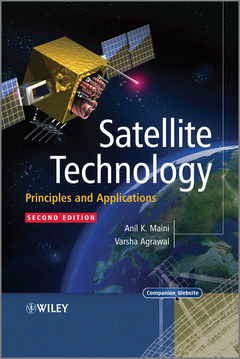Description
Satellite technology: principles & applications (2nd Ed.)
Authors: MAINI Anil Kumar Mr, AGRAWAL Varsha Ms
Language: English
Subjects for Satellite technology: principles & applications:
Approximative price 120.38 €
In Print (Delivery period: 14 days).
Add to cart672 p. · Hardback
Description
/li>Contents
/li>
PART I
SATELLITE TECHNOLOGY 1
1 Introduction to Satellites and Their Applications
1.1 Ever-expanding Application Spectrum
1.2 What is a Satellite?
1.3 History of the Evolution of Satellites
1.4 Evolution of Launch Vehicles
1.5 Future Trends
Further Reading
Glossary
2 Satellite Orbits and Trajectories
2.1 Definition of an Orbit and a Trajectory
2.2 Orbiting Satellites - Basic Principles
2.3 Orbital Parameters
2.4 Injection Velocity and Resulting Satellite Trajectories
2.5 Types of Satellite Orbits
Further Reading
Glossary
3 Satellite Launch and In-Orbit Operations
3.1 Acquiring the Desired Orbit
3.2 Launch Sequence
3.3 Orbital Perturbations
3.4 Satellite Stabilization
3.5 Orbital Effects on Satellite's Performance
3.6 Eclipses
3.7 Look Angles of a Satellite
3.8 Earth Coverage and Ground Tracks
Further Reading
Glossary
4 Satellite Hardware
4.1 Satellite Subsystems
4.2 Mechanical Structure
4.3 Propulsion Subsystem
4.4 Thermal Control Subsystem
4.5 Power Supply Subsystem
4.6 Attitude and Orbit Control
4.6.1 Attitude Control
4.6.2 Orbit Control
4.7 Tracking, Telemetry and Command Subsystem
4.8 Payload
4.9 Antenna Subsystem
4.10 Space Qualification and Equipment Reliability
Further Reading
Glossary
5 Communication Techniques
5.1 Types of Information Signals
5.2 Amplitude Modulation
5.3 Frequency Modulation
5.4 Pulse Communication Systems
5.5 Sampling Theorem
5.6 Shannon-Hartley Theorem
5.7 Digital Modulation Techniques
5.8 Multiplexing Techniques
Further Reading
Glossary
6 Multiple Access Techniques
6.1 Introduction to Multiple Access Techniques
6.2 Frequency Division Multiple Access (FDMA)
6.3 Single Channel per Carrier (SCPC) Systems
6.4 Multiple Channels Per Carrier (MCPC) Systems
6.5 Time Division Multiple Access (TDMA)
6.6 TDMA Frame Structure
6.7 TDMA Burst Structure
6.8 Computing Unique Word Detection Probability
6.9 TDMA Frame Efficiency
6.10 Control and Coordination of Traffic
6.11 Frame Acquisition and Synchronization
6.12 FDMA vs. TDMA
6.13 Code Division Multiple Access (CDMA)
6.14 Space Division Multiple Access (SDMA)
Further Reading
Glossary
7 Satellite Link Design Fundamentals
7.1 Transmission Equation
7.2 Satellite Link Parameters
7.3 Frequency Considerations
7.4 Propagation Considerations
7.5 Techniques to Counter Propagation Effects
7.6 Noise Considerations
7.7 Interference-related Problems
7.8 Antenna Gain-to-noise Temperature (G/T) Ratio
7.9 Link Design
Further Reading
Glossary
8 Earth Station
- Earth Station
- Types of Earth Stations
- Earth Station Architecture
- Earth Station Design Considerations
- Earth Station Testing
- Earth Station...




